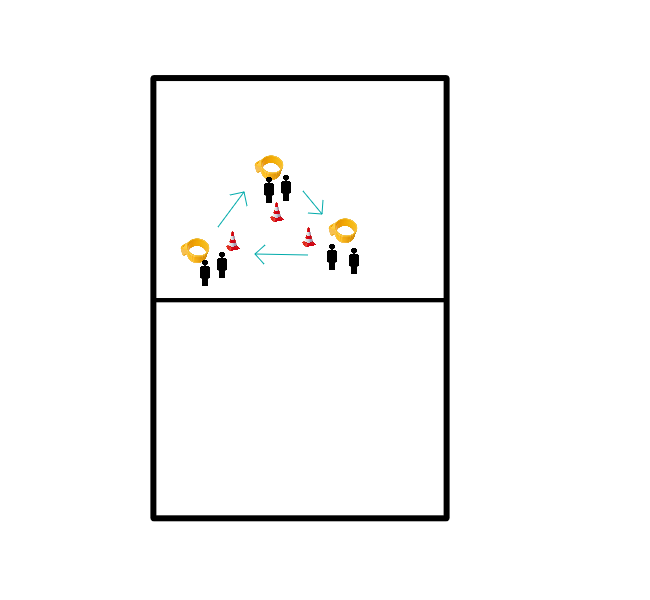Korfball drills
The whole group walks a circle around the yellow lines in the middle in a line. When the trainer calls 'yes', the person at the back of the line starts running as fast as possible. The children do this by pulling a sprint.
Options:
The children run after each other around the yellow lines in a line. The person at the front of the line can do whatever he wants for example: heels buttocks, sprints, lifts his knees etc. Whenthe trainer calls 'yes' the person at the back of the line starts to run as fast as possible and can choose what he wants to do. It must be something other than normal running/jogging, it may be sprinting.
 You have a pair at each pole, so the amount of poles depends on the size of the group. Everyone starts with scoring twice on the pole, when they have done this they go to the next pole. It can happen that two groups are standing at the same pole, this is because they don't all have to turn. The pairs only have to pass when they have scored twice.
You have a pair at each pole, so the amount of poles depends on the size of the group. Everyone starts with scoring twice on the pole, when they have done this they go to the next pole. It can happen that two groups are standing at the same pole, this is because they don't all have to turn. The pairs only have to pass when they have scored twice.
Place a pawn in front of the pole at a good distance for your team.
You make a square, in it stands an attacker, the attacker must keep moving in the square while a defender walks by. 1 person always plays the ball. The defender looks at the ball and tries to catch it. Every time the attacker catches the ball, someone else comes into the box. When the defender catches the ball, he throws it back and you try again.
The children make a walk-through ball in front of the basket and a walk-through ball behind the basket. If they both hit the hoop, they have three points. The first player to get three points wins.
Place a number of cones/caps 2 to 3 metres apart. Make two rows of cones and divide the team into two groups.
The exercise is quite simple. Two pawns spinning and one pawn in defensive position back. Then repeat the exercise again, so two pawns forward and one pawn back.
You make a square, in it stands an attacker, the attacker must keep moving in the square while a defender walks by. 1 person always plays the ball. The defender looks at the ball and tries to catch it. Every time the attacker catches the ball, someone else comes into the box. When the defender catches the ball, he throws it back and you try again.
At the end of the training, play a game of 4 against 4 on 1 basket.
Nr.1 has the ball and after the start signal passes to Nr.2, etc. The distance between the players is 2 m. The last player runs forward after receiving the ball, taps the wall (or other point). Places on nr.1 and goes in front of the line. 1 places again on 2, etc.Â
This continues until the whole row has moved forward and no. 1 is in front again.
Organisation:
Two parties, 1 attacking and 1 defending party. Three or four baskets and a ball.
Exercise:
How much time does a team need to score a goal in all the baskets?
The basket that has been scored in may not be used again, so that the difficulty factor increases. The defender gives the ball back after interception.
Organisation:
Put 4 poles in a square, about 8 metres apart. In the middle of that square, place 4 pawns in a square, about 2 metres apart.
Four children stand under the basket and the others take three minutes to play pass-backs. Every time they have done that, they walk back to the middle and search for another basket.
After those 3 minutes, the attackers change.
Who will get the most in the 3 minutes?
Attention:
the pace must be high!
Organization:
Baskets in a square, gentlemen first under the basket with ball.Â
Ladies in the middle. After a shot or a walkthrough ball, move to the next post through the middle (players are not allowed to hit the same post twice).
Format:
Two teams, 1 ball, 4 poles. Posts are in a square.
Exercise:
Teams play over and try to hit the pole.
First 3 minutes right hand, then 3 minutes left hand.
Which team scores the most points?








